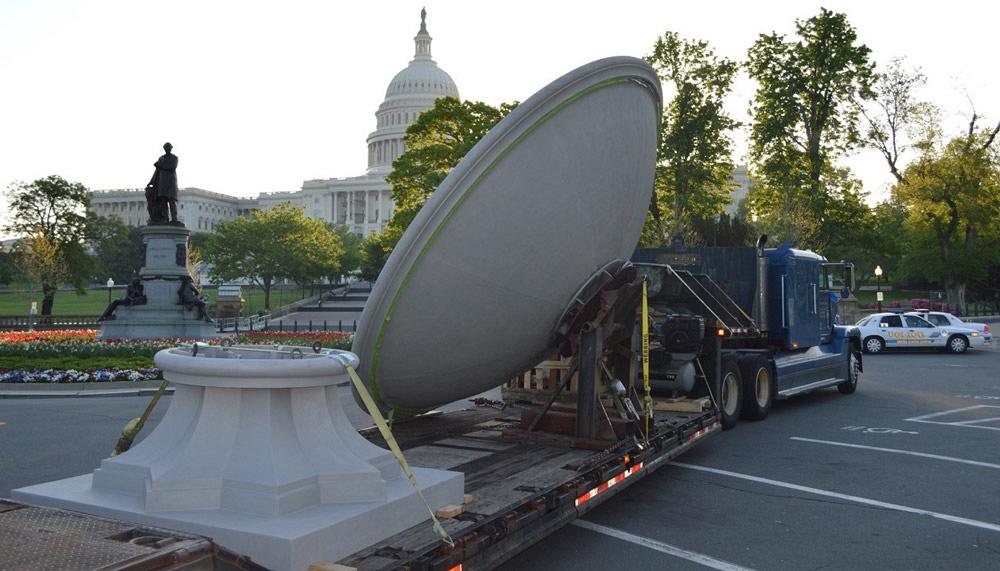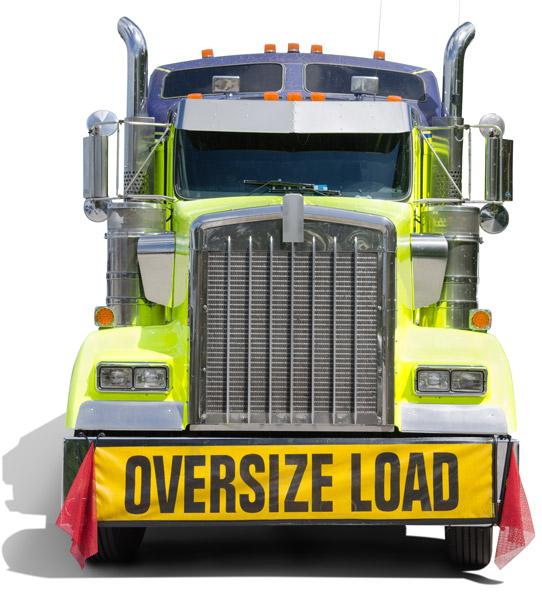Contributing Writer
- FMA
- The Fabricator
- FABTECH
- Canadian Metalworking
Categories
- Additive Manufacturing
- Aluminum Welding
- Arc Welding
- Assembly and Joining
- Automation and Robotics
- Bending and Forming
- Consumables
- Cutting and Weld Prep
- Electric Vehicles
- En Español
- Finishing
- Hydroforming
- Laser Cutting
- Laser Welding
- Machining
- Manufacturing Software
- Materials Handling
- Metals/Materials
- Oxyfuel Cutting
- Plasma Cutting
- Power Tools
- Punching and Other Holemaking
- Roll Forming
- Safety
- Sawing
- Shearing
- Shop Management
- Testing and Measuring
- Tube and Pipe Fabrication
- Tube and Pipe Production
- Waterjet Cutting
Industry Directory
Webcasts
Podcasts
FAB 40
Advertise
Subscribe
Account Login
Search
Moving big fabrications
Fabricators share their stories of taking their work on the road
- By Jeffrey Dean
- September 2, 2015
- Article
- Materials Handling
In 1917 a designer named John Cullen was commissioned with creating a themed park—early 20th century style. It was to be a museum-like site evoking European monasteries of the Middle Ages and to have an authentic look.
To Cullen, a stickler for detail, that meant eschewing reproductions. Why have a fake monastery, he reasoned, when you could have the real deal?
So sections of three monasteries, circa 13th century, were dismantled and brought, stone by stone, from Europe to New York City. When the pieces arrived, they were painstakingly reassembled.
The Cloisters in Washington Heights, N.Y., stands today as a testament to this concept: Go ahead and design it, and don’t fret over how the project will be delivered. With enough planning and elbow grease, anything can be moved. Of course, you just have to know how to go about it.
But first things first. Once a shop has fabricated a large job, the first decision is not how but who is going to move it. A shop has two options. It can use a commercial mover, usually referred to as a common carrier, or it can choose to do the heavy lifting itself. The factors that figure into this choice include distance to installation, size of the piece, and a shop’s experience and level of comfort in such an undertaking. Everything else is logistics.
Delivery of large fabrications isn’t taught in trade schools. Fabricators gain this experience over time. Here are their stories.
Getting It on the Truck
Whether a shop is moving the fabrication itself or using a common carrier, the first hurdle to clear is getting the piece from the shop to the actual conveyance—in most cases, a flatbed trailer. A crane certainly would do the trick, too, and many shops have overhead cranes. But quite a few smaller shops do not. Of course, there’s always the option of renting a crane, but that involves costs that have to be built into the bid. With cranes being a might pricey to rent, some going for as much as $500 per hour, some fab shops may want to explore another avenue.
Mill City Iron Fabricators, Manchester, N.H., elected to go without a crane to load a 60-foot elevator tower that it had fabricated in its shop.
“We went with a common carrier. They brought a truck with a 55-ft., low-bed flatbed trailer. We own forklifts, and we positioned four of them, two at each end on either side of the piece while it was lying on its side. The forklifts raised it up, and the driver just backed the flatbed under it, between the forklifts,” said Nicholas Soucy, Mill City Iron’s estimator.
“We’d loaded stuff like this before. We’ve shipped monster I-beams this way.”

Figure 1
Robinson Iron’s 6-ft.-wide urn is tilted to avoid the need for oversized-load permits as the delivery is made to the U.S. Botanic Garden in Washington, D.C.
Soucy said that the flatbed measured 8.5 ft. wide while the piece was 12 ft. wide. Road permits were needed because of the overhang. The carrier took care of the permits.
The moral: Solutions for loading oversized pieces often don’t involve a crane. Many shops have a forklift or two or access to one, and they can make that work.
But what does a shop do when it has a very large job and has neither a forklift nor a flatbed? Furthermore, what if the shop wants to avoid the additional cost of a common carrier? How does it move a large piece like that? It doesn’t. Not as one piece.
The Great Urn of Alabama
Robinson Iron, Alexander City, Ala., has a good example of how to fabricate a large piece in several parts to facilitate shipping. This involved a rather large urn that was delivered to the United States Botanic Garden in Washington, D.C. Standing 6 ft. high, the cast aluminum structure consists of both the bowl and the base it rests on.
In anticipation of the moving logistics, the fabricator designed the job in five sections. The bowl itself was cast in quadrants. Since that meant making five separate patterns, obviously, moving the job was a consideration from day one of the planning process. The five sections were designed to be gas metal arc welded together at the installation site.
After the pieces were cast, the next step was to figure out how to actually move them. Even in sections, the largest piece was 103 in. But if set on a flatbed trailer with a tilt rig, it would not exceed the 13 ft. that would render it an oversized load. (More on those criteria later.)
Another way to stay within the limits of oversized parameters is to use a drop-bed trailer.
Both of these methods take care of staying under the height limits, but when trailering, height is more of an issue than width. While width is a legal limit, height is a physical limit, given the various bridges, overpasses, and toll booths along the way.
Once loaded onto the tilt-rig trailer (see Figure 1), the urn began its 13-day journey from the Heart of Dixie to 100 Maryland Ave. in D.C.
J. Scott “Scotty” Howell, Robinson Iron’s vice president/general manager, recalled that the move was without event because of a few basic rules of thumb. First, the company brushed up on the rules and regulations of transport for each state the urn transited. It determined what constituted an oversized load for each state. It’s always best, Howell said, to avoid oversized loads, and fabricating in sections is the best way to accomplish this. But occasionally even the sections are so big they become oversized loads.
This is where drop-deck and tilt rigs become fabricators’ friends. But when they still have to deal with oversized loads, they should follow through and get the permits. Each state has its own, so a company has to contact the transportation departments for each state the fabrication is passing through. Sometimes, depending on the load’s oversized dimensions, it may even require an escort or two.

Figure 2
Valley Bronze shipped this cast aluminum statue of Major-General Sir Isaac Brock, a Canadian hero from the War of 1812, in two pieces to an installation site in Toronto.
Gary Gassett, production manager for Valley Bronze, Joseph, Ore., is also an advocate of designing large pieces in parts for easier shipping.
“We can design the piece to be cast with flanges so it can be bolted together at the site,” Gassett explained.
This was how they moved a 15-ft. statue of Canadian hero Sir Isaac Brock from Oregon to Toronto, a 2,500-mile trek (see Figure 2).
“The client really didn’t want it in two pieces, but that was what we needed to do to get it there,” Gassett added.
Best-laid Plans
Sometimes, despite all the careful planning, surprises occur.
In the late 1990s, Harvard University decided to replace the clock tower on its Memorial Hall. According to school officials, the tower, gutted by fire in 1956, it had suffered its decapitated state long enough. Mill City Iron got the contract to build the superstructure for the new tower.
Rather than build on-site, Mill City Iron fabricated the structure in-house.
“The more we can do in-house, the less welding on the install end,” Soucy explained.
The plan was sound. Anticipating the move, Mill City built it in four separate pieces, cubes that would be less cumbersome to move and could be hoisted easily into place atop the building and connected with a minimum of welding.
Yet even the smaller cubes turned out to be too large to fit through the shop door. They ended up breaking down one of the building’s brick walls. The cost to repair the wall, however, was minor compared to the revenue and prestige of the job.
“It was worth it,” Soucy said.
Mill City Iron is not the first or last to resort to such structural renovation to the shop to remove a fabricated job. The locals of Berlin, N.H., may still remember when the now defunct Isaacson Steel took down part of its roof to remove a structural job for Liberty Mutual in Massachusetts.
Some innovations are less drastic. Novel Iron Works, Greenland, N.H., has done some creative rigging to avoid oversized loads. Bill Gallant, the plant manager, said he has found an interesting way to avoid the necessity for permits on many of his shipping projects.
“We fabricated some supports that are adjustable,” he said. “They can shift the load right or left or up and down. The piece can be skewed on the trailer so it’s either not as high or not as wide. We built them years ago and keep them in the shop. We cut some slots in the bed of the trailer, and they just bolt on.”
Reducing the height of the piece can mean the difference between being required to have one or two escorts. According to Gallant, it can even eliminate the need to have an engineer’s road survey if transporting a large load through the state of Massachusetts.
The Rules of the Road
While all states have their own rules and regulations regarding transiting of oversized loads on their roads, the states’ rules also have a surprising amount of uniformity. On the low end of the complexity spectrum is New Hampshire, where a fabricator needs a permit for anything over 8.5 ft. wide and 13.5 ft. tall.
On the other end of the spectrum is California. The web page for overweight and oversized road shipping has a list of 23 frequently asked questions.
A good resource is a website called www.over size-done-right.com. The website notes that several multistate consortiums offer regional permits for trips that will cross several state lines, but remain in one region of the country. The largest of these consortiums covers most of the South and includes Alabama, Arkansas, Florida, Georgia, Kentucky, Mississippi, Missouri, North Carolina, Ohio, Louisiana, South Carolina, Tennessee, Texas, Virginia, and West Virginia.
One caveat regarding these multistate permits: Some balkanization occurs, resulting in some states dropping out of the group.
Doing a Little of Both
For some fabricators, the decision between hauling the fabrication themselves or using a common carrier isn’t a mutually exclusive proposition. For Central Minnesota Fabricating (CMF) Inc., Willmar, Minn., it’s often a concerted effort. For some jobs, the fabricator uses its own flatbed trailer but has a common carrier provide the truck to pull it. Other times it just uses both the carrier’s truck and trailer.
“It depends mainly on the distance to the site,” said Cathy Hedlof, CMF’s operations manager. “If it’s a long distance, we let the carrier use its own trailer, so it doesn’t have the back haul.” A back haul of the customer’s trailer would add considerably to the cost.
Another advantage to using the common carrier’s truck is that the carrier handles the permits and routing.
And for very long items, the routing is no small thing. Hedlof recalled a 100-ft.-long structural box frame for a skyway between two buildings on the University of St. Thomas’ campus in St. Paul, Minn. The carrier drove the route before the actual trip to determine whether the structure could make the turns they would encounter during the haul.
This type of advance planning goes into all CMF’s jobs right from the bidding stage.
“When we bid, we ask if this job really is within our capacity. How much can we actually lift and haul? Can we get it out the door? Can we deliver it? All this figures into the costs for the bid,” Hedlof said.
Fabricators also need to consider one last variable in the logistics of moving large jobs: Mother Nature. In the nation’s warmer climates, weather may not be much of a factor. In the North, however, weather and seasons usually have a great impact on moving things down public roads.
Apart from the more obvious storms and ice, many areas have road restrictions in the spring. This is common throughout the U.S. where the ground temperature is slowly increasing from 32 degrees during the spring.
Hedlof said she recalled one job that was promised in April but couldn’t be delivered until May because it would have exceeded Minnesota’s road weight limits for the spring.
“Never say never and don’t say always in the steel fabrication business,” Hedlof said.
That certainly applies to delivering large fabrications.
About the Author
subscribe now

The Fabricator is North America's leading magazine for the metal forming and fabricating industry. The magazine delivers the news, technical articles, and case histories that enable fabricators to do their jobs more efficiently. The Fabricator has served the industry since 1970.
start your free subscription- Stay connected from anywhere

Easily access valuable industry resources now with full access to the digital edition of The Fabricator.

Easily access valuable industry resources now with full access to the digital edition of The Welder.

Easily access valuable industry resources now with full access to the digital edition of The Tube and Pipe Journal.
- Podcasting
- Podcast:
- The Fabricator Podcast
- Published:
- 04/16/2024
- Running Time:
- 63:29
In this episode of The Fabricator Podcast, Caleb Chamberlain, co-founder and CEO of OSH Cut, discusses his company’s...
- Trending Articles
Steel industry reacts to Nucor’s new weekly published HRC price

How to set a press brake backgauge manually

Capturing, recording equipment inspection data for FMEA

Are two heads better than one in fiber laser cutting?

Hypertherm Associates implements Rapyuta Robotics AMRs in warehouse

- Industry Events
16th Annual Safety Conference
- April 30 - May 1, 2024
- Elgin,
Pipe and Tube Conference
- May 21 - 22, 2024
- Omaha, NE
World-Class Roll Forming Workshop
- June 5 - 6, 2024
- Louisville, KY
Advanced Laser Application Workshop
- June 25 - 27, 2024
- Novi, MI



























